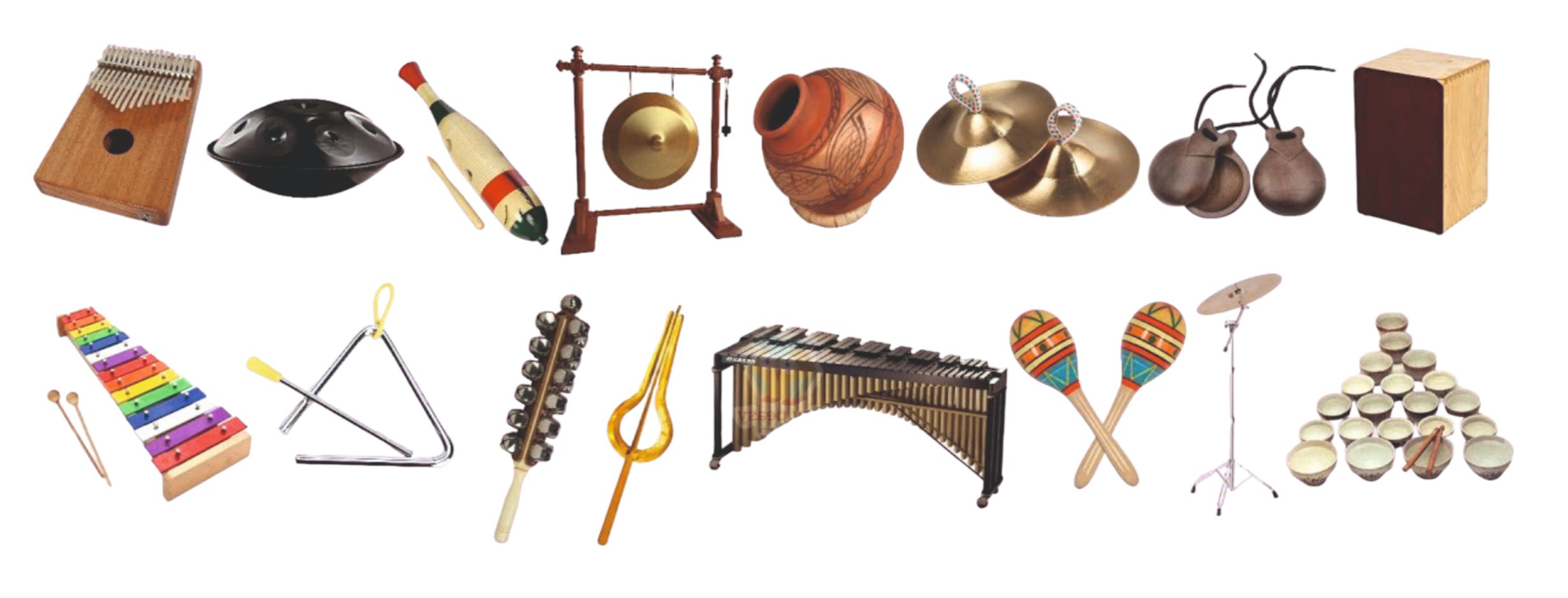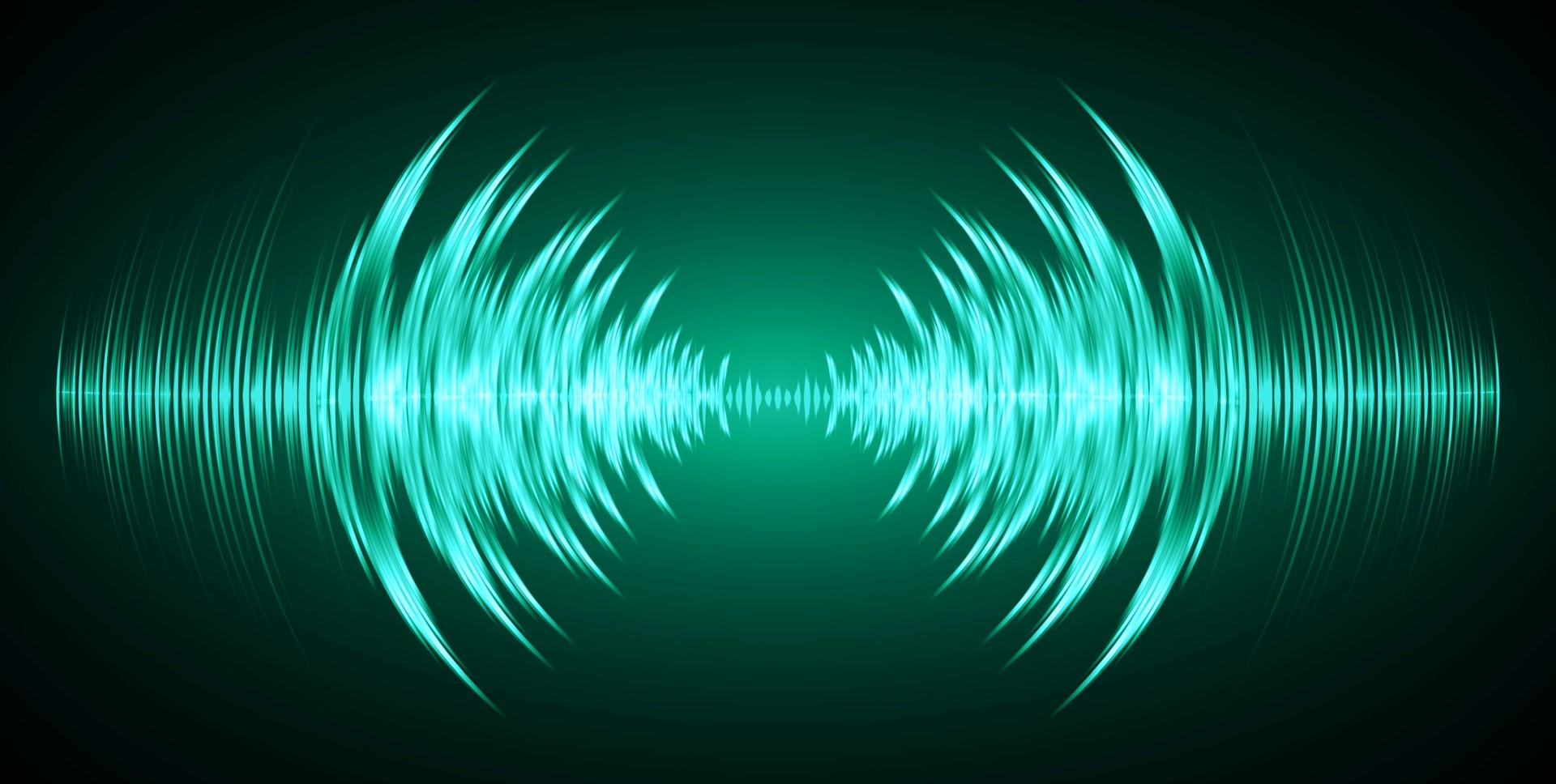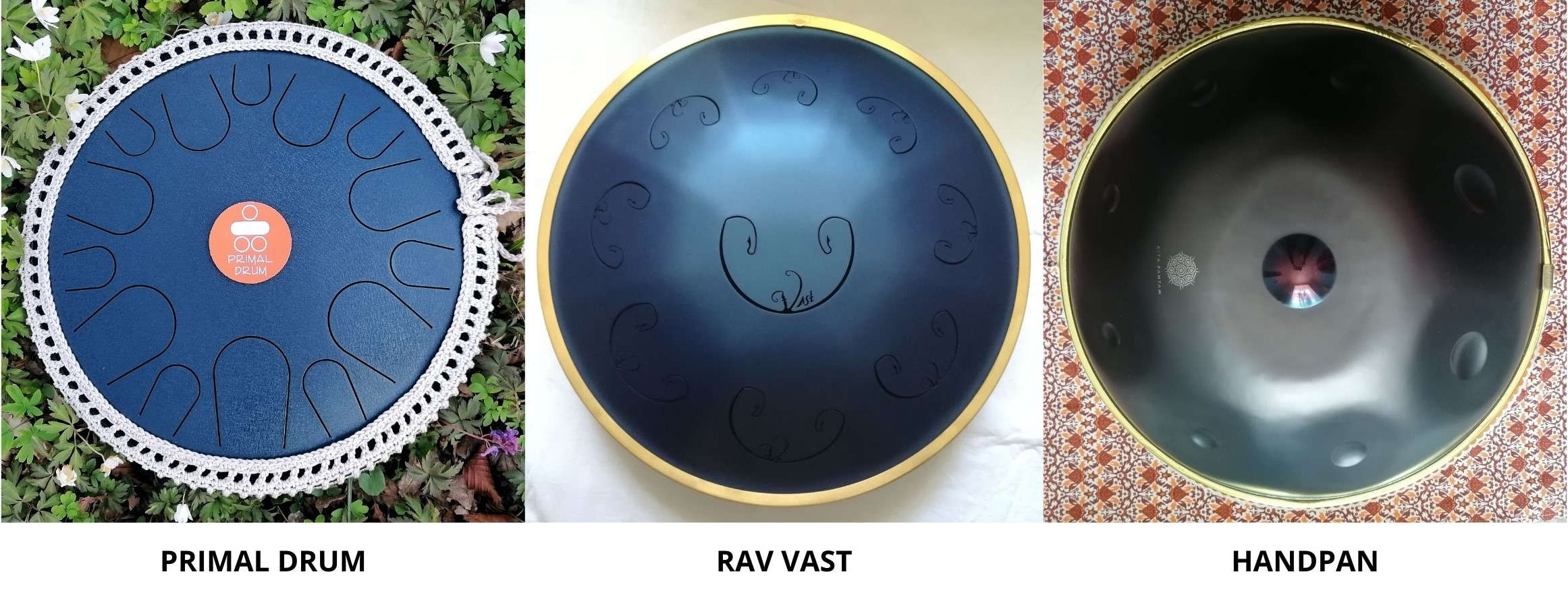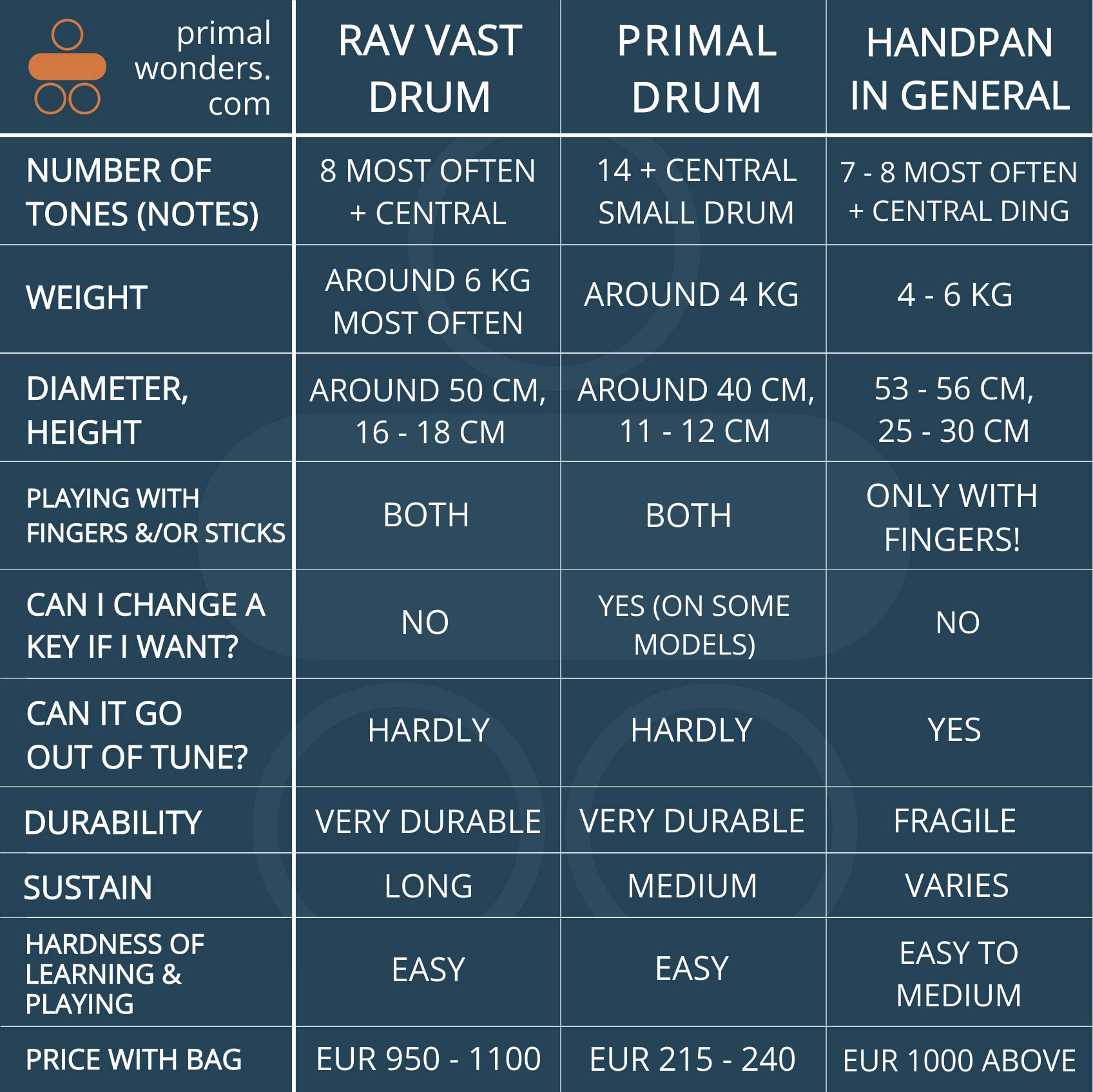Handpan, RAV Vast, Primal drum: review in detail
INTRODUCTION TO THE REVIEW
What are differences and similarities between these three beautiful musical instruments – handpan, Primal drum and RAV Vast drum? One thing is sure, all three are otften being called by the same names – handpan. Although RAV Vast and Primal drum are specific brands of the same group of instruments called tongue steel drums (also known as tank drums, since the first such instruments were made of small gas tanks). When we talk about handpan here, we talk about specific type of instruments and not one particular brand. All the musical instruments in this comparison are members of the idiophone family so let’s talk about that first.
IDIOPHONE MUSICAL INSTRUMENTS

According to online encyclopedia Britannica “Idiophones are instruments whose own substance vibrates to produce sound (as opposed to the strings of a guitar or the air column of a flute).” You can create the sound by either directly or indirectly striking the instrument. They stand for rhythmic instruments in various global civilizations. Aside from the instruments we are comparing here, idiophones also include percussion instruments like gong, bell, triangle, castanets, maracas, marimba, xylophone, kalimba, mbira, sound bowls, cymbals, claves, chelpan, and others.
Now that we have clarified the etymology, we can start with a comparison and it can even serve you as a shopping guide. 😊
LOOKS
As we already mentioned, handpan is not just one instrument but a group of instruments that look quite similar to each other. They all have the same oval shape that reminds many of UFO with several dimples spread around. And in the middle there is a bulge with a flat plate around it. This bulge is called a ding and around the dimples there are handpan tones (notes). There are many manufacturers of handpans in the world so each of them gives a slightly different finish to their instrument. It probably won’t be recognizable to an amateur or a beginner player, but an experienced one will notice the differences.
Unlike handpan, RAV Vast drum and Primal drum belong to the group of instruments which is called – steel tongue drums. Steel indicates the material and the tongue (an English word) indicates cuts, i.e. tongues on the top of the instrument. Each of these tongues represents one tone (note).
Primal drum doesn’t have a tone in the middle like RAV Vast has. Instead, it has a small drum called Primo. It serves only as a rhythmic element.
HOW TO PLAY THESE INSTRUMENTS?
Each handpan is played by hitting the “flat” rings around the dimples. There are usually 7 or 8 of them, and rarely 9 or 10. Don’t hit the dimples as this may damage the instrument. In addition to the regular playing of tones in a circle and a ding in the middle (the deepest tone and bass), handpan can also be played by hitting the shell of the instrument. These notes are so-called ghost notes and they serve as a rhythmic elements.
All tongue drums, including RAV Vast and Primal drum, are played by hitting tongues with fingers or special rubber-tipped sticks. Also, there is possibility to play ghost notes. RAV Vast usually has 8 tones around the central tone, while Primal drum has 14 tones around the central Primo.
With every handpan and RAV Vast, the center tone is the deepest one of all. With Primal drum it’s little different – there is a small drum in the center. Other tones of all these instruments are arranged in a circle in the way it really makes sense – all tones are part of a particular musical scale. Notes in scale don’t go one after the other in a circle (like most of first-time players think); notes are going right – left – right – left and so on. That is why it’s very important that you place the instrument in front of you in the way that the deepest tone is closest to your body.
Technically described like this, playing these instruments maybe sounds complicated, but when you try it yourself, you’ll see that it’s actually simple and logical. You can even see with your eyes which tone has deeper and which tone has higher sound. Why is that? Because with handpan, dimples around the ding get bigger when tones are deeper. Accordingly, with RAV Vast and Primal drum, the tongues around central ding (or Primo) are getting larger when tones are deeper.
HOW HARD IS TO LEARN IT & PLAY IT?
My first contact was with RAV Vast and it lasted about a minute or two because I was so uncomfortable of the people around me. It seemed like every note I “played” with my fingers sounded almost the same, or didn’t sound at all. This scenario is entirely possible and not unusual, as I discovered only later by watching other people ”playing” one of these three instruments for the first time in their life.
The great thing is that my second contact with RAV Vast was completely different. 😊 I figured out the scale and started getting cleaner and cleaner tones, with a lot of mistakes, of course. After an hour I was playing some easy and slow rhythms and after two hours I was playing even some lively rhythms.
Similarly, I’ve noticed that most people learn to play Primal drum this way. With me, in the other hand, learning to play it went quite quickly because I had already been playing RAV Vast (several scales) for some time.
I obtained handpan last. Although it was my first and greatest wish, I found out it was good for me that I had been playing two other instruments every day for more than a year before. Why? Because handpan is somewhat more difficult to play, it requires better hand technique, hand coordination, technique of hitting the instrument with the fingers. Also, handpan requires faster and more dynamic playing, primarily because of its sustain. Because of all this, handpan requires more practice, more will, more trial and error. Also, I’d say the size (girth) of handpan is kind of a drag at first, especially if you have shorter arms, like me.
Another observation of mine concerns how these three instruments sound when played in beginnings of learning and after a short time. What I’ve noticed is that RAV Vast and Primal drum can sound very good at the very beginning if played with sticks. They even sound very good when you play them with fingers just after a short time of a few hours or a few days of practice. I have various experiences with handpan, i.e. it can sound nice at first, but it won’t sound very good if the person haven’t played any kind of drums before or if the person isn’t a natural talent.
SUSTAIN

What does word sustain mean in music? Sustain is a parameter of musical sound over time. As its name implies, it denotes the period of time during which the sound remains before it becomes inaudible or silent. In general, sustain of a musical instrument depends on several factors, which is why each handpan has a different sustain from short to long, depending on the type of material, manufacturing technique, wall thickness, etc. Every handpan maker knows his instruments in depth and will be able to answer you what to expect.
With RAV Vast and Primal drum, the situation is much more simple. With them, sustain is almost equal for every drum in the exact tuning. Almost equal means that there may be some deviations, but very small. RAV Vast drums have the longest sustain and are therefore are best for slow or medium speed playing. Primal drums have a slightly shorter sustain than RAV and are therefore suitable for both slower and faster playing. A general rule of thumb in practice is that handpan has a shorter sustain and is therefore best suited for faster playing. However, with a slightly larger financial investment in handpan, it can have a slightly longer duration. However, from my own experience I would say that the most of RAV Vast drums have longer sustain than the average handpan.
DURABILITY, TUNING, MAINTENANCE
Although these questions are not directly related to playing these musical instruments, they are very important and often overlooked by players, most often by beginners. I’ll say it directly: handpan is one of the most sensitive instruments I’ve came across in my life and it requires more care and maintenance than a guitar, keyboards, djembe, violin…
The first reason for this is the specific construction and material that makes it sensitive to scratches, salt and moisture in the air, direct (strong) sunlight and, of course harder hits with fingers. Such hits can cause some of the tones to get out of tune, which makes handpan unusable so you’ll must give it to the maker for repair. It can cost you anywhere from 100 to 200 euros plus shipping both ways if the maker is not near your place of living. Some makers guarantee free tuning in first year after buying their handpan.
With this instrument, tones are tuned by hammer (pneumatic and classical) hits, so it’s not surprising that just by playing, even without hitting hard, gradually over time some tones start to go out of tune. What time do you have until it happens? It depends on how much time and how hard you play, what quality the instrument is and do you play in the sun during hot days. With better quality handpan, tuning will last longer.
After playing handpan, you won’t be able to just put it in your bag and forget about it because it could quickly start to rust. After each playing, I recommend that you wipe it gently with a so-called ”magic cleaning cloth” and occasionally you do it with a special anti-rust oil for handpan. You can do it every few months or even more frequently if you play near the sea or in places with high air humidity. Don’t keep it in a closed bag for a long period of time, unless you put a special moisture absorber in the bag (you can order it in our webshop HERE).
RAV Vast is much more durable, although it can be scratched, like if you don’t take jewelry off your hands and wrists. The brass edge oxidizes over time (it doesn’t rust like many owners get afraid!), so it can be polished once or twice a year for nicer looks. After each playing, I recommend wiping the instrument with a ”magic cleaning cloth”. Every few months it’s good to coat it with special oil. It’s very very difficult that it will go out of tune by simply playing with your fingers. However, some people report that playing with sticks intensively for long period of time can cause slight changes in tuning. Personally, I don’t have experiences with that.
Primal drum is very durable and doesn’t require any special maintenance, apart from wiping with some cleaning cloth. You can add some water to cloth when your hands are sweaty or there is a lot of salt in the air (at the sea). Although it’s not easy to scratch (the test was done by two kindergarten children-experts 😊), I recommend that you remove jewelry from your hands and wrists before playing. It’s the best to do this when playing any kind of drums. Similar to RAV, it’s very difficult to detune Primal drum with simple finger play. Playing with sticks intensively for long periods of time can cause a slight changes in tuning. Personally, I don’t have experiences with that.
PRICES, MODELS
What interests everyone is the price of these instruments.
Let’s start with RAV Vast. In the moment I’m writing this review, there are about 20 different Rav Vast models, and they differ in scale and color. Sizes and shapes are the same. Their price ranges from approx. 900 euros for most common scales up to approx. 1150 euros for some unusual scales. Don’t forget to add the cost of the bag and delivery, and if desired, the cost of playing sticks and rope braid to protect the brass edge.
Prices of Primal drum depend on the scale and they range from approx. 215 to 240 euros including sticks, braid around the edge, bag and built-in LED light for easier night playing and creating atmosphere. There are currently 3 scales, and there will likely be more over time.
The story on handpan prices is a bit more complicated. Namely, each maker determines prices of their instruments and those prices can be more or less realistic. Price usually depends on these factors: quality of manufacture, materials used, hardness and duration of manufacture, durability of tuning, the country from which it comes, and also the reputation and years of work of the manufacturer. In the end of the day, what turns out to be an unwritten rule is that you won’t be able to get a quality handpan for less than approx. 1000 euros plus the cost of the bag and shipping. Yes, you’ll probably be able to get handpan for less than 1000 euros from some new maker on market. BUT it’s quality could be questionable, in terms of beauty of the sound, precision of the tuning, stability of the tuning, the length of sustain, the appearance of instrument itsefl etc.
What you have to pay special attention to is the ability to maintain (repair) the instrument by the maker after you purchase it. First question is whether the maker offers the possibility of repairing handpan in the event that one or more of tones go out of tune or instrument starts to rust or gets damaged in any way. Also, if your maker is situated in different country than you are, you should ask yourself if it would be worth sending the instrument to them for re-tuning.
SIZE, WEIGHT, TRANSPORT
Handpan is the largest instrument in this comparison. You’ll need a lot of room in your car for it and in bus you’ll need one extra seat. Concidering the weight, it can be the same as Primal drum and RAV Vast, or it can be a heavier if you carry it in a hard case or some other thick bag. In any case, if you intend to play any of these three instruments outside of your home or studio, I recommend getting the original bag so you can transport them safely.
Original bag for RAV Vast drum is around 50 euros, while the prices for the handpan bag range from 70-80 euros to 150 or 200 euros, depending on whether it’s a soft case (less protection), a hard case (stronger protection) or something in between. You get the original Primal drum bag for free but check that before buying.
For a lot of people, a bag for handpan or RAV Vast is too expensive investment at the time of buying an instrument, so they often leave it out with a plan to buy it in a certain period of time. Honestly, I don’t recommend doing this. First, for the reason that receiving these instruments in a package via delivery will be safer if they are in a bag. Second, because it will cost you more then buying the bag if you damage the instrument when having no bag. This is especially true for handpan.
CONCLUSION

If you red this review in whole, you’ll know there isn’t much dilemma. If you have enough money, my honest advice is to get one of all three instruments. Why? First of all, because each of them is different and creates a special atmosphere. I can’t imagine to say one is better or worse than other so the real questions are – what you plan to do with it and what your budget is.
If you plan to busk on street and make money that way, then I definitely recommend a better quality handpan from a proven maker. Find one that’s as loud as possible and make sure you can try it out, or at least hear it in live if you don’t play it yet. If you plan to play for fun at home or among close friends, and you don’t have a big budget, then Primal drum could be ideal for you. It’s not so loud that the neighbors can hear it and complain BUT it’s loud and distinctive enough and has top quality so you can enjoy its sound alone or as part of a drum circle. If you plan to perform sound baths and do some kind of sound therapy, RAV Vast could be your ideal choice! Your investment in it will probably pay off after some time of performing.
Altough, be sure that you can go out on some more quiet street and busk using RAV Vast or Primal drum; be sure you can play handpan and RAV Vast alone at home and in a drum circle; be sure you can do relaxing sound baths and sound therapies with both Primal drum and handpan – just as me and many others in the world do. It all mostly depends on your personal affinities, taste in music and, of course, your budget.
Conclusion? It’s up to you, as always! 😊
WANT ADVICE ON BUYING?
Not sure what to choose and could use some advice from personal experiences?
No problem, you can contact us HERE by e-mail or message us through our social networks.
RAV VAST, PRIMAL DRUM, HANDPAN – COMPARISON CHART
Ready to find your wonder?
“There are NO limits. There are plateus, but you must not stay there, you must go beyond them. A man must constantly exceed his level.” ―

